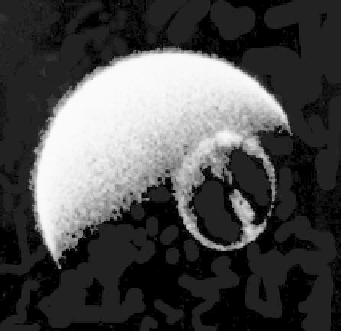Geoscience Reference
In-Depth Information
Figure 10.11b
Image of the auroral oval and a transpolar arc in the southern hemisphere
at 0022 UT on May 11, 1983. The combination of continuous luminosities around the
auroral oval and a transpolar arc can produce a pattern of luminosities which, when
viewed from polar latitudes, is reminiscent of the Greek letter
. Such auroral distributions
are generally referred to as “theta” auroras. The dayglow and auroral emissions observed
in this image are predominantly form neutral atomic oxygen at 130.4 and 135.6 nm.
(Figure courtesy of L. A. Frank, J. D. Craven, and R. L. Rairden, University of Iowa.)
θ
may be understood as follows. The flow vorticity, a measure of velocity shear,
is defined as the curl of the velocity field:
W
=∇×
V
(10.2)
As usual, let the
z
direction be downward parallel to the magnetic field and
the
B
2
is
independent of
z
. If we consider a flow field parallel everywhere to the arc and
in the direction
a
x
direction along the arc. For
E
z
=
ˆ
0, the plasma flow velocity
E
×
B
/
a
x
, then the vorticity has only a
z
component,
ˆ
W
=−
(∂
V
x
/∂
y
)
ˆ
a
z
=
W
z
ˆ
a
z
(10.3a)
Suppose for simplicity that we take the height-integrated Pedersen conductivity
to be uniform in the horizontal plane. This would occur for a weak arc or for
an arc in the sunlit hemisphere. Then, because
V
B
2
, we have
=
E
×
B
/
J
z
=
P
(∂
E
y
/∂
y
)
=
P
B
(∂
V
x
/∂
y
)
and thus
J
z
=−
P
BW
z
(10.3b)
This equation shows that
J
z
is out of the northern hemisphere ionosphere when
W
z
is positive and into the ionosphere when
W
z
is negative. Since precipitating

Search WWH ::

Custom Search